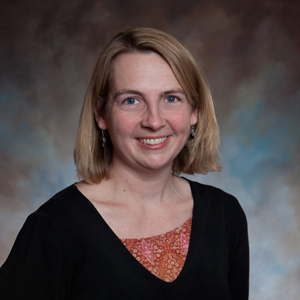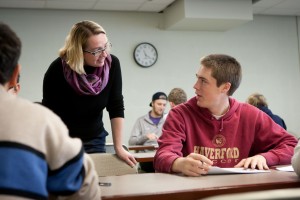Jenn Rossmann, associate professor of mechanical engineering and department head, on how engineering benefits a liberal arts education.

A liberal education introduces a wide range of methods of inquiry: “ways of knowing” the human condition and the world. These methods include, for example: the close, informed reading of literature; the observation, interview instruments, and statistical analysis of social research; and the scientific methods of observation and analysis. The methods, values, and history of engineering provide another facet in the prismatic 21st century liberal education. And of course, the more facets a prism has, the more light and colors are revealed: the more fully we see each other and the world.
We prize the many benefits Lafayette engineers receive from their liberal arts courses, context & experiences: their communication and critical thinking skills; their appreciation of history and the societal context in which they hope to practice engineering; their development of ethics, professionalism, and empathy; and the opportunities they have to participate in the arts, athletics, and other pursuits. However, we have traditionally been less vocal about what the presence of engineering on Lafayette’s campus offers other students. Engineering methods and values transcend discipline, and can provide an interesting lens on the world.
Read about Lafayette’s STEAM Camp
For example:
• Engineering design is an iterative process in which human needs guide the definition and refinement of a “problem;” possible creative solutions are developed and evaluated; and prototypes are constructed and tested; with continuous feedback and revision. Successful designs are human-centered, founded on a designer’s empathy with a wide range of stakeholders. Empathy, not incidentally, is extraordinarily well developed by the broad reading, writing, and critical thinking involved in, and refined by, a liberal education. In developing and evaluating solutions, engineering designers must resolve competing objectives, think critically in matching the “best” solution to its social context, and navigate the ambiguity of a non-unique solution space. This method is widely applicable, transcending engineering practice.
• In engineering design and in many engineering courses, students work collaboratively. They are taught strategies for effective collaboration; they learn that a team project involves stages of energetic attack, negotiation of roles and standards, and respectful disagreement, before a team can work together toward a common goal.
• Many engineering concepts are widely relevant. For example, engineers use the laws of thermodynamics to consider the feasibility of alternative energy sources. When non-engineers read about wind farms, fracking, ethanol subsidies, or have to decide whether to buy an electric car, they are well served by such knowledge.
• Engineering knowledge helps the College develop responsible technological citizens. This means asking questions, and not thinking of your phone, car, or airplane as a “black box,” whose workings are abstract and mysterious. The agile intellectual curiosity fed and fueled by a liberal education should include an appreciation and critique of technology: how it works, how it is made, how it was developed, how it is distributed, and so on.
Lafayette offers many routes for non-engineering students to gain literacy in engineering methods and “ways of knowing.”

Professor Jenn Rossmann speaks with students during her Engineering Science course.
The annual Lafayette Forum on Technology and the Liberal Arts brings experts from various fields to our campus, and fosters community dialogues on relevant topics. Courses designed to include and engage non-engineers in the methods, history, and values of engineering are often taught as First-Year or Science and Technology in Social Context seminars. For nearly 50 years, we have had an interdisciplinary degree program (Engineering Studies) leading to an A.B. in Engineering, in which students explore the interconnections of engineering, economics, societal issues, and policy. And in all our engineering programs, we encourage students from all backgrounds to participate in inter- and multi-disciplinary design projects, often with entrepreneurial components.
The National Academy of Engineering in 2008 issued a set of “Grand Challenges” to motivate engineering educators and engineers to consider concerns such as clean water, energy availability, and global health. These challenges comprise technical issues intertwined with geopolitics, economics, and other factors. At Lafayette, we have emphasized the socio-technical nature of these Challenges and recruited multidisciplinary student teams. In working together to define and address context-specific design problems, students from all backgrounds gain appreciation for the methods, values, and history of other disciplines.
The liberal arts are often distinguished from the “useful arts” or professionally-oriented vocations. But history teaches us, regularly and reliably, that engineers focused solely on the technical and “useful” will not yield better bridges, safer dams, or more elegant cellular phones. Engineering is about serving humanity, so an understanding of the human condition is central. And for those pursuing non-engineering majors, the methods and values of engineering might be “useful,” too.
But we do not become educated only because it is “useful;” we do so to comprehend the human condition, in order to become humans who may lead meaningful lives. Developing literacies and lenses that include engineering is part of a 21st century liberal education. Here at Lafayette College, the methods and values of engineering – design, collaboration, applied scientific analysis – increase the perspectives available to educated citizens.


2 Comments
Comments are closed.